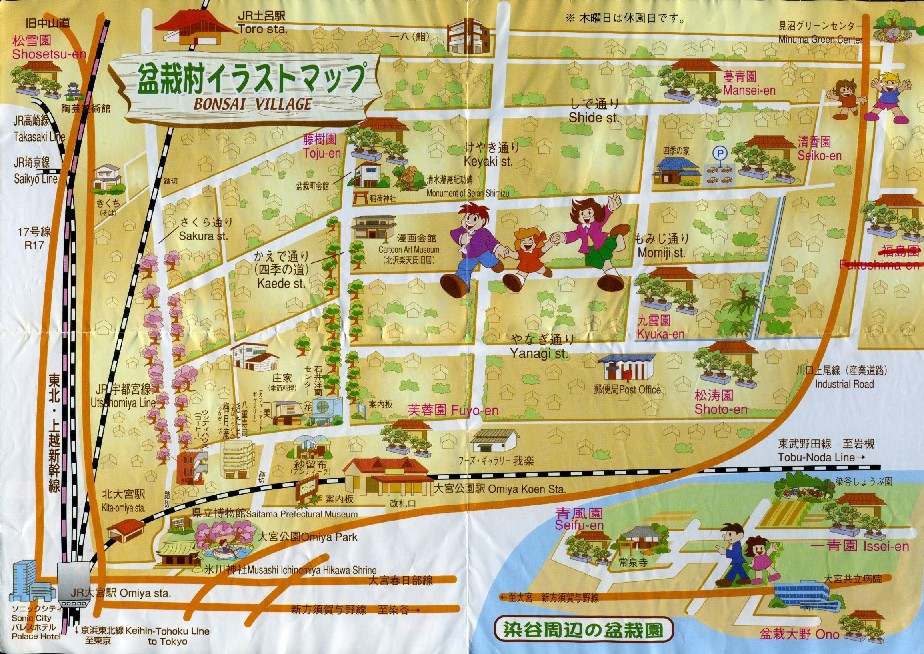
|
This Page Last Updated: April 12, 2025 |
|
|
|
|
|
|
|
Bidai-en
|
1929
|
<1974
|
|
|
|
1939
|
|
Fusazo Takeyama (c.1914-1979), studied under Utsumi Gennojo ; Hiroshi Takeyama | 96 Bonsai-cho |
|
Hansen-en
|
1927
|
<1974
|
|
Shide-dori |
|
Ikko-en
|
1945
|
<2014
|
|
|
|
Kamimari-en
|
1938
|
<1974
|
|
|
|
Kanko-en
|
1950
|
<1974
|
|
|
|
Kanruku-en
|
1927
|
<2000
|
|
|
|
Kawaraduka-en
|
1931
|
<1974
|
|
Keyaki-dori |
|
Kinko-en
|
1925
|
<1974
|
|
|
|
Koseki-en
|
1925
|
<1974
|
|
Kaede-dori |
|
Kosho-en
|
1925
|
<1974
|
|
|
|
Kujaku-en
|
1931
|
<1974
|
|
Shide-dori |
|
Kunju-en
|
1938
|
<1974
|
|
Sakura-dori |
|
Kunpu-en
|
1925
|
<1974
|
Atsuo Kuraishi (1900-?) |
|
|
1929
|
|
Kyuzo Murata (1902-1991), Isamu Murata (1937-2021), Yukio Murata | 131 Bonsai-cho |
|
Manko-en
|
|
<1974
|
|
|
|
Mansei-bunen
|
1947
|
<1974
|
|
Shide-dori |
|
Mansei-en
|
1925
|
|
Tomekichi Katō (1883-1946), then Saburō (1915-2008), Hatsuji (1942-2018), Haruhiko, and now Takahiro | 285 Bonsai-cho |
|
Matsuyama-en
|
1937
|
<1974
|
|
Shide-dori |
|
Nanshu-en
|
1934
|
<1974
|
|
Sakura-dori |
|
Ryuho-en
|
1943
|
2006/<2014
|
|
236 Bonsai-cho |
|
Seidai-en
|
1925, April
|
<1974
|
Ritaro Shimizu (1874-1955) | Omiya's first bonsai nursery |
|
1943
|
|
Kamajiro Yamada (3rd generation), Tomio Yamada (4th), Kaori Yamada (5th) [Garden was originally opened in the oldest downtown area of Tokyo, what is now Negishi, Taito Ward (after 1947), during the Kaei era (1848-54)] | 268 Bonsai-cho |
|
Sensho-en
|
1939
|
<2000
|
|
|
|
Shiko-en
|
1926
|
<1974
|
|
|
|
Shimizu-en
|
1931
|
<1974
|
|
|
|
Shoka-en
|
1941
|
<1974
|
|
|
|
Shorai-en
|
1929
|
<1974
|
|
|
|
Shosetsu-en
|
1977
|
|
Teruo Kurosu, studied under Motosuke Hamano | 2-640 Higashi Onari-cho |
|
Shoto-en
|
1974
|
|
Taeko Komuro | 112-4 Bonsai-cho |
|
Shuko-en
|
|
<1974
|
|
Kaede-dori |
|
Shunka-en
|
1930
|
<1974
|
|
Kaede-dori |
|
Suchiro-en
|
1931
|
<1974
|
|
|
|
Taiko-en
|
c.1983
|
<2014
|
|
Kaede-dori |
|
Taisho-en
|
1929
|
<1974
|
|
Shide-dori |
|
1929
|
|
Motosuke Hamano, Hiromi Hamano | 247 Bonsai-cho |
|
Unju-en
|
1925
|
<1974
|
Ariga Senkichi | Momiji-dori |
|
Utsumi Ka-en
|
1925
|
1939?
|
Utsumi Gennosuke / Gennojo | Kaede-dori |
|
|
|
|
|
|




by The Omiya Bonsai Art Museum, with existence in the year 2000 based on Bonsai-in-Asia; plus additional details from Kyuzo Murata; Katō Family and Mansei-en; Feb Also; "Omiya Bonsai Village" by Bonsai Empire; "Omiya Bonsai Six Gardens", which states that Toju-en was started in 1931; "About Bonsai" by The Omiya Bonsai Art Museum; "Saitama International Bonsai Academy"; "Bonsai master Kaori Yamada" * ; "A Private Visit to Omiya Bonsai Village" by William N. Valavanis, February 13, 2019; In personal email to RJB , November 5, 2023 states that "[Fuzo Takeyama's] master passed away during his training, and he was able to open the [Fuyoen] garden with the help of various people in the village." and "Ayumi of Bonsai Village 80 years (created by adding and modifying based on the exhibition panel of the 80th anniversary of the opening of Omiya Bonsai Village and the 'commemorative magazine' Last updated: May 29, 2014)", brought to RJB's attention by Adam Webster, 04 Jul 2021, Google Translation into English. It is stated here that Motosuke Hamano's "Fujijuen" opened in 1928. (The next line states that "World War I occurs" [sic].) Also, it states that Shinji Ogasawara's "Seifuen" was opened in 1948. However, according to Ogasawara's May 25 Bonsai Book of Days listing, the original founding in 1948 was "at Takeyama near the ocean," and it was about fourteen years later that "he moved his nursery Seifu-En to Omiya since the ocean air and strong winds at the Tateyama location were proving unfavorable to good bonsai growing and maintenance." The following locations are listed in this article but not on the official map above: |
|
Ariake-en
|
1963
|
<2000
|
Saburo Ariyama |
|
|
Ichisei-en
|
1974
|
<2000
|
Noboru Kaneko |
|
|
Kanraku-en
|
1939
|
<2000
|
Gozaburo Nakamura |
|
|
Kaoru-en
|
1925, May
|
<2000
|
Atsuo Kuraishi |
|
|
Komatsu-en
|
1925
|
<2000
|
Ishida Shinjiro |
|
|
Matsuo-en
|
1974
|
<2000
|
Kakutaro Komuro |
|
|
Matsuyuki-en
|
1977
|
<2000
|
Teruo Kurosu |
|
|
Seifu-en
|
c.1962
|
<2014
|
Shinji Ogasawara (1918-2006) |
|
|
Tsui Sei-en
|
1925, August
|
<2000
|
Kato Ryukichi |
|
|
Yagumo Mansei-en
|
1947
|
<2014
|
Hideo Kato (1918-2001) |
|
|
Yoshiishi-en
|
1925
|
<2000
|
Yonezu Umejiro |
|
|
|
|
|
|
|
See also these short Omiya Bonsai Village 100th Anniversary - Promotion Video 1 ; Omiya Bonsai Village 100th Anniversary - Promotion Video 2 ; Omiya Bonsai Village 100th Anniversary - Promotion Video 3 (longer) ; Hikaru Takahashi becomes an ambassador for the 100th anniversary of Omiya Bonsai Village. And the Omiya Bonsai Art Museum Bonsai Book of Days listing, Mar 28. |